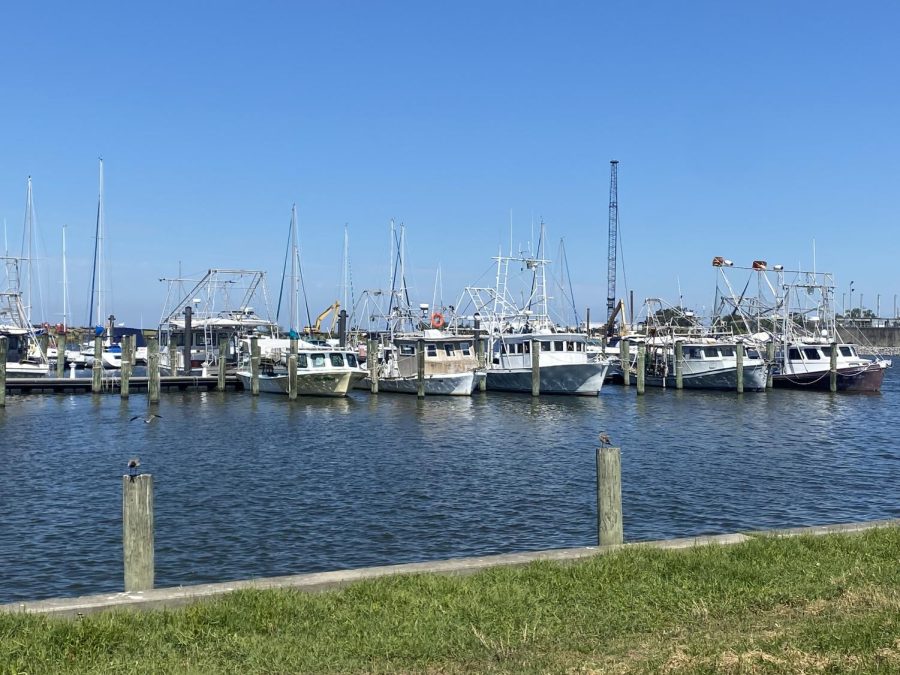New Orleans fishing industry suffers sourcing issues
Shrimp boats in Bucktown Harbor.
December 2, 2022
Fishing runs through Merlin Schaeffer’s blood. He has been fishing in Louisiana waters for decades, and before him, so were his father and his grandfather. While primarily a fisherman in Lake Pontchartrain, Schaeffer is also the owner of Schaeffer’s Seafood. Located in Bucktown, a small community that thrives on the fishing industry, Schaeffer’s is a shop that sells anything from crabs to shrimp to catfish.
Because fishing is a touch-and-go job, fishermen often lack routine and certainty when they head out to work, he said.
“You gotta go with the flow, around the weather, the bite, the tide, it goes off a lot, the sails,” Schaeffer said. “Everything varies.”
This variance includes prices as well.
“Prices have been going up, but then they took a hard crash,” he said. “The sales up North are going down, because of the storm.”
This storm was Hurricane Ian, which struck the east coast in late September this year.
Deflating prices are especially detrimental to an industry still dealing with the effects of its own natural disaster. It’s been a year since Hurricane Ida struck a struggling fishing industry in New Orleans. Schaeffer said that the industry was already lacking support from the state government prior to Hurricane Ida, and assistance in the wake of the hurricane was sparse.
“There are so many restrictions on what they assist with. It’s hard for people to get it,” Schaeffer said.
Schaeffer also struggled with getting the product, as crabs were driven away by the storm. This leaves local fishermen with little or nothing to sell, and no money to be made. With rejected subsidies and almost no monetary support from the government, “fishermen are at a loss” Schaeffer said.
Now, Merlin Schaeffer struggles with the opposite problem, an excess of crabs driven down the coast by the effects of Hurricane Ian. However, this is not long-term, he said.
Just like fishermen, customers can never know what to expect. According to Schaeffer, domestic seafood has been rising in price for years, and labor costs, fuel prices, and inflation have added to the costs of commercial fishing.
According to Schaeffer, customers have had to pay more, and now it’s finally starting to adjust.
“Everything went up with inflation. With every new delivery we get, you get a price hike,” Schaeffer said. “From seafood, fish, shrimp, to paper products, plastic products, everything’s going up.”
This fluctuation in seafood prices and availability as well as high gas prices makes people buy from more convenient places that often don’t provide domestically-caught seafood, according to Schaeffer.
“They buy it from the grocery store,” Schaeffer said. “I see a lot of seafood from South America, where it’s coming from out the Gulf, just down south.”
Cheaper labor in the Gulf along South America means big industries there can sell seafood in America slightly cheaper than domestic fishermen and pocket the difference. This also leads to confusion among customers who believe they are actually buying domestically caught seafood.
At Loyola, Charlie Casrill, the general manager of Loyola dining, assures that the seafood served weekly is domestically sourced.
“The catfish, shrimp, and crawfish are sourced from Louisiana Seafood that is located in New Orleans, and buys local seafood for distribution,” Casrill said.
Louisiana Seafood ensures that local companies can bulk buy locally caught seafood and connects fishermen with the type of sales they need, according to Casrill.
As for the seafood not bought through Louisiana Seafood, Sodexo said they ensure the product served is ethically sourced and sustainable.
With growing efforts to shop locally and ethically Schaeffer said a needed boost to the local fishing industry could be coming. He said he looks forward to reaping the rewards that come from spending his days along rough waters, making sure that the Louisiana seafood industry doesn’t die.








Not sure • Dec 5, 2022 at 12:03 pm
This is false and misleading, shrimp prices at the dock are lower than they were 40 years ago, let that sink in, yes customers are paying more out the front door but the seafood has NEVER went in the back door cheaper. PLEASE FACT CHECK THIS
Kathy Vignes • Dec 3, 2022 at 4:24 pm
Wonderful article Sydney. Someone needs to shine the light on Louisiana commercial fishermen. I always make sure what I am buying is local not from China.